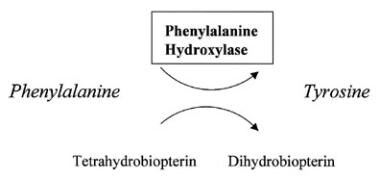Practice Essentials
Phenylketonuria (PKU), less commonly known as phenylalanine hydroxylase deficiency, is the most common inborn error of amino acid metabolism. For the sake of familiarity, the terms PKU and phenylketonuria will be used in the article. A deficiency of the enzyme phenylalanine hydroxylase (PAH) impairs the body’s ability to metabolize the essential amino acid phenylalanine. This leads to accumulation of phenylalanine in body fluids.
Elevated phenylalanine levels negatively impact cognitive function, and individuals with classic PKU almost always have intellectual disability unless levels are controlled through dietary or pharmacologic treatment.
Signs and symptoms
Skin findings in PKU are as follows:
-
Fair skin and hair: Resulting from impairment of melanin synthesis, this is the most characteristic cutaneous manifestation of PKU. It can be striking in black and Japanese patients, although not all untreated patients are fair; treated patients often have typical pigmentation
-
Eczema (including atopic dermatitis)
-
Light sensitivity
-
Increased incidence of pyogenic infections
-
Increased incidence of keratosis pilaris
-
Decreased number of pigmented nevi
-
Sclerodermalike plaques
-
Hair loss [1]
Other manifestations of untreated PKU are as follows:
-
Intellectual disability (the most common finding overall)
-
Musty or mousy odor
-
Epilepsy (50%) [2]
-
Extrapyramidal manifestations (eg, parkinsonism)
-
Eye abnormalities (eg, hypopigmentation)
Diagnosis
Screening for PKU involves the following:
-
Determination of phenylalanine levels: The standard amino acid analysis done by means of ion exchange chromatography or tandem mass spectrometry
-
The Guthrie test as a bacterial inhibition assay: Formerly used, but now being replaced by tandem mass spectrometry
-
Molecular testing is generally unnecessary for a diagnosis of PKU; however, limited genotype-phenotype correlation has been described. In addition, molecular testing is required for prenatal diagnosis.
Imaging studies
Cranial magnetic resonance imaging (MRI) studies may be indicated in older individuals who have abandoned the diet used to manage PKU and are experiencing deficits in motor or cognitive function, or in cases in which behavioral, cognitive, or psychiatric concerns exist. Prolonged exposure to elevated phenylalanine levels has been found to be detrimental to white matter integrity. [3] In terms of volume loss, the most severely affected brain structures are the cerebrum, the corpus callosum, the hippocampus, and the pons. [4]
Management
Dietary management and/or pharmacologic treatment are essential for patients with PKU.
Dietary treatment
The mainstay of dietary management for patients with PKU consists of phenylalanine restriction, as well as the use of medical foods to supplement the patient’s intake of other essential amino acids and of vitamins and minerals. [5] Energy and variety are provided by low-protein foods, including fruits, nonstarchy vegetables, and specially ordered low-protein items.
Pharmacologic management
Sapropterin (Kuvan) is a synthetic form of BH4, the cofactor for the enzyme PAH. It is indicated to reduce blood phenylalanine levels in patients with hyperphenylalaninemia (HPA) caused by tetrahydrobiopterin (BH4)–responsive phenylketonuria (PKU).
Pegvaliase (Palynziq) is a PEGylated phenylalanine ammonia lyase (PAL) that substitutes for the deficient PAH enzyme activity in patients with PKU and reduces blood phenylalanine concentrations. [6]
Pharmacologic therapies are used in conjunction with dietary management.
Patients who have suboptimal dietary treatment may benefit to some degree from consuming large neutral amino acids, which may block phenylalanine entry into the brain and may also result in a modest lowering of plasma phenylalanine levels.
Some patients with PKU experience significant lowering of plasma phenylalanine levels after administration of sapropterin, a form of the tetrahydrobiopterin (BH4) cofactor. [7] Patients with some residual enzyme activity are more likely to respond than are patients with no residual enzyme.
Background
Phenylalanine hydroxylase (PAH) deficiency, better known as PKU, is the most common inborn error of amino acid metabolism. It results from an impaired ability to metabolize the essential amino acid phenylalanine, leading to accumulation in blood and tissues.
Several different classifications have been used in the past to describe PKU severity. Commonly, classic PKU is considered to be present when untreated plasma phenylalanine levels exceed 20 mg/dL (1200 µmol/L) without treatment. Lesser degrees of plasma phenylalanine elevation are often referred to as hyperphenylalaninemia. The American College of Medical Genetics and Genomics has released a practice guideline acknowledging that PAH deficiency represents an unbroken spectrum of disease. [8] While this change in nomenclature is being adopted, providers will likely continue to use previous terminology.
Elevated phenylalanine levels negatively impact cognitive function, and individuals with classic PKU almost always have intellectual disability unless levels are controlled through dietary or pharmacologic treatment.
In the United States and many other countries, PKU is detected by newborn screening, and individuals who are appropriately treated (eg, with a diet low in phenylalanine and/or tetrahydrobiopterin) can have normal intelligence and lead a normal life.
Pathophysiology
In most patients, the classic type of PKU involves a deficiency of PAH that leads to increased levels of phenylalanine in the plasma (>1200 µmol/L; reference range, 35-90 µmol/L) and to excretion of phenylpyruvic acid (approximately 1 g/d) and phenylacetic acid in the urine. Phenylalanine hydroxylase catalyzes the conversion of L-phenylalanine to L-tyrosine, the rate-limiting step in the oxidative degradation of phenylalanine
The enzyme PAH crystallizes as a tetramer, with each monomer consisting of a catalytic domain and a tetramerization domain. Examination of the mutations causing PKU reveals that some of the most frequent mutations are located at the interface of the catalytic and tetramerization domains.
The mechanism by which elevated phenylalanine levels cause intellectual disability is not known, although restriction of dietary phenylalanine ameliorates this effect if initiated within a few weeks of birth. A strong relation between control of blood phenylalanine levels in childhood and intelligence quotient (IQ) is recognized.
Subtle neuropsychological deficits in children with treated PKU are under investigation. Some investigators have attributed these deficits to small residual neurotransmitter abnormalities (eg, reduced production of neurotransmitters as a result of deficient tyrosine transport across the neuronal cell membranes).
Phenylalanine hydroxylase requires a nonprotein cofactor termed tetrahydrobiopterin (BH4). A small percentage of children with elevated phenylalanine levels exhibit normal PAH levels but have a deficiency in synthesis or recycling of BH4 known as tetrahydrobiopterin deficiency. This condition is sometimes termed malignant PKU and can result from biallelic mutations in the GCH1, PCB1, PTS, or QDPR genes. The BH4 cofactor is also required for hydroxylation of tyrosine (a precursor of dopamine) and tryptophan (a precursor of serotonin). Thus, individuals with BH4 cofactor deficiency can have additional neurologic problems that are not fully corrected by dietary phenylalanine reduction alone, but often require additional treatments that may not be fully effective.
Etiology
Phenylketonuria (PKU) is an autosomal recessive disorder caused by mutations in the PAH gene, which expresses PAH. This gene is located on 12q23.2, spans about 171 kb, and contains 13 exons. More than 500 different mutations in the PAH gene have been identified.
The PAH gene shows great allelic variation, and pathogenic mutations have been described in all 13 exons of the PAH gene and its flanking region. The mutations can be of various types, including missense mutations (62% of PAH alleles), small or large deletions (13%), splicing defects (11%), silent polymorphisms (6%), nonsense mutations (5%), and insertions (2%). [9]
The 3 genes related to biopterin synthesis defects are located at 11q22.3-23.3, 10q22, and 2p13, and the gene for biopterin recycling defects is located at 4p15.1-16.1.
Phenylketonuria displays a marked genotypic heterogeneity, both within populations and between different populations. There is some broad genotype-phenotype correlation (alleles that tend to be severe and alleles that tend to be mild), but unrelated individuals with identical mutations have some degree of variability in phenylalanine tolerance.
Epidemiology
United States statistics
Phenylketonuria (PKU) frequency varies by population. The prevalence in the general US population is approximately 4 cases per 100,000 individuals, and the incidence is 350 cases per million live births. Approximately 0.04% to 1% of the residents in intellectual disability clinics are affected by PKU. A low incidence is reported in African Americans (1:50,000).
International statistics
A high incidence is reported in Turkey (approximately 1 case in 2600 births), the Yemenite Jewish population (1:5300), Scotland (1:5300), Estonia (1:8090), [10] Hungary (1:11,000), Denmark (1:12,000), France (1:13,500), the United Kingdom (1:14,300), Norway (1:14,500), China (1:17,000), Italy (1:17,000), Canada (1:20,000), Minas Gerais State in Brazil (1:20,000), [11] and the former Yugoslavia (1:25,042). [12] A low incidence is reported in Finland (< 1:100,000) [13] and Japan (1:125,000). [9]
Age-, sex-, and race-related demographics
Phenylketonuria is most commonly diagnosed in neonates because of newborn screening programs. Consider PKU at any age in an individual with developmental delay or intellectual disability because infants are missed by newborn screening programs on rare occasions.
No sex predilection is known. Women with PKU must restrict their phenylalanine levels during pregnancy to avoid birth defects and intellectual disability in their infants. Untreated PKU during pregnancy can result in maternal PKU syndrome, which can variably cause congenital heart defects, brain malformations, microcephaly, and intellectual impairment.
In the United States, PKU is most common in whites. Worldwide, PKU is most common in whites and Asians.
Prognosis
The prognosis for normal intelligence is excellent when patients have been put on a diet low in phenylalanine in the first month of life, with careful monitoring. However, school functioning can be mildly impaired in some children, particularly when dietary control is poor.
A quantitative, proportional relation exists between blood phenylalanine levels and intelligence quotient (IQ) for early-treated patients with phenylketonuria (PKU) assessed either during the critical early childhood years (age 0-12 y) or by a lifetime Index of Dietary Control. A 100-μmol/L increase in phenylalanine has resulted in a 1.3- to 4.1-point reduction in IQ. [14]
Patients with PKU who are treated early and continuously can have a normal health-related quality of life and course of life. [15] Well-treated patients should have IQs within approximately 5 to 8 points of their siblings.
Most untreated individuals with PKU have profound intellectual disability. After the discovery of PKU, routine testing of institutionalized patients with intellectual disability identified a 1% incidence of PKU in this group.
Psychiatric disorders have been frequently described among individuals with PKU, including anxiety, depression, personality disorders, and psychosis. Interestingly, psychiatric comorbidities were less common in younger patients than older patients with PKU. [16] Treated patients with PKU can experience subtle performance and attention and behavioral changes, especially when phenylalanine levels exceed 360 µmol/L.
Patient Education
Teach parents how to administer the diet at home, and involve all caregivers as well. Children should begin involvement in their dietary planning as soon as they are developmentally ready. Poor dietary control is often associated with increasing noncompliance by older children, but it could also be due to a more relaxed dietary approach by parents and increasing dietary errors. [17]
Women with phenylketonuria (PKU) should be educated about the risks of untreated pregnancy and the benefits of dietary and, in some cases, pharmacologic, treatment. Patients with PKU should avoid aspartame (an artificial sweetener). Aspartame is widely used in medicines, vitamins, beverages, and other substances.
The phenylalanine-restricted diet with semisynthetic supplementation is not without risk. Patients with PKU under dietary treatment can have low concentrations of trace elements and cholesterol and can have some disturbance to folate metabolism and distortion of their fatty acid profile. [9] Patients may also have decreased intake of calcium, vitamin D, and vitamin B12.
The organization National PKU News is a nonprofit entity dedicated to providing accurate news and information to families and professionals dealing with PKU. This site contains excellent articles and links to other information sources. Information on how to subscribe to a PKU newsletter and on how to contact support groups is available. Numerous other PKU Web sites are available to assist families in search of additional information.
-
Phenylalanine hydroxylase converts phenylalanine to tyrosine.
-
Fair skin and hair resulting from impairment of melanin synthesis.











